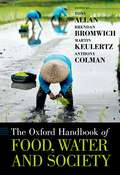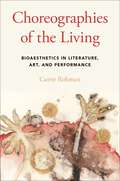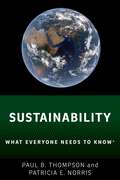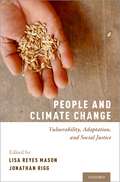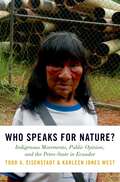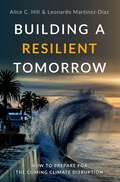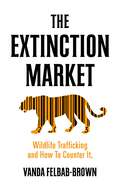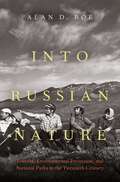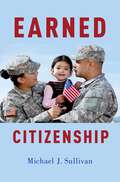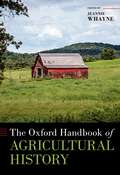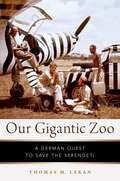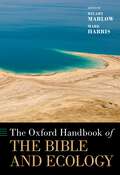- Table View
- List View
The Oxford Handbook of Food, Water and Society (Oxford Handbooks)
Food, water and society: what is managed by whom, and with what impacts? Our food supply chains are at risk. Water resources--sometimes scarce, often damaged, and always under-valued--are among the major reasons why food and water security rank high every year in the World Economic Forum's major global risk analysis. A stable and sustainable food system is critical to society's survival. This Handbook shows that keeping the food system stable comes at the expense of the environment, especially of water resources and those who consume and manage them. The way the food system operates reflects hard political realities. Rather than pay for the environmental costs of sustainable production, society expects food at ever lower prices. Governments reflect their electorates in this regard. Given that farm production may account for as little as 10% of the food value chain in wealthy economies, it is striking that governments have been unwilling (or unable) to put in place the essential laws and accountability that would enable famers to ensure both production and stewardship. Corporate food traders, food manufacturers, and retailers on the other hand operate in markets that make profits and pay taxes. But these corporations are not contractually bound to utilize highly nutritious, sustainably produced food commodities. The articles in this Oxford Handbook have been written by water and food system scientists and professionals, including farmers, rarely heard voices who understand the problems of food producers, food manufacturers, and regulating markets and public policy. The articles address the blind spots of society and its public policymakers, demonstrating the importance of informing society about the consequences of its food preferences and the heroic challenges it is beginning to face. The damage we are doing to our water and soil ecosystems is as important as the damage we do to the atmosphere. Impressed by the technical and organizational advances of the past two centuries, the contributors featured in this book also take note of where economic inefficiencies and cultural deadlock in a 4,000 year old system are putting our critical food supply chains at risk.
CHOREOGRAPHIES OF THE LIVING C: Bioaesthetics in Literature, Art, and Performance
by Carrie RohmanChoreographies of the Living explores the implications of shifting from viewing art as an exclusively human undertaking to recognizing it as an activity that all living creatures enact. Carrie Rohman reveals the aesthetic impulse itself to be profoundly trans-species, and in doing so she revises our received wisdom about the value and functions of artistic capacities. Countering the long history of aesthetic theory in the West--beginning with Plato and Aristotle, and moving up through the recent claims of "neuroaesthetics"--Rohman challenges the likening of aesthetic experience to an exclusively human form of judgment. Turning toward the animal in new frameworks for understanding aesthetic impulses, Rohman emphasizes a deep coincidence of humans' and animals' elaborations of fundamental life forces. Examining a range of literary, visual, dance, and performance works and processes by modernist and contemporary figures such as Isadora Duncan, D. H. Lawrence, Virginia Woolf, and Merce Cunningham, Rohman reconceives the aesthetic itself not as a distinction separating humans from other animals, but rather as a framework connecting embodied beings. Her view challenges our species to acknowledge the shared status of art-making, one of our most hallowed and formerly exceptional activities.
Sustainability: What Everyone Needs to Know® (What Everyone Needs to Know)
by Paul B. Thompson Patricia E. NorrisWhile politicians, entrepreneurs, and even school children could tell you that sustainability is an important and nearly universal value, many of them, and many of us, may struggle to define the term, let alone trace its history. What is sustainability? Is it always about the environment? What science do we need to fully grasp what it requires? What does sustainability mean for business? How can governments plan for a sustainable future? This short, accessible book written in the signature question-and-answer format of the What Everyone Needs to Know® series tackles these and numerous other questions. Sustainability is a porous topic, which has been adapted and reshaped for developing ecological models, improving corporate responsibility, setting environmental and land-use policies, organizing educational curricula, and reimagining the goals of governance and democracy. Where other treatments of this topic tend to focus on just one application of sustainability, this primer encompasses everything from global development and welfare to social justice and climate change. With chapters that discuss sustainability in the contexts of profitable businesses, environmental risks, scientific research, and the day-to-day business of local government, it gives readers a deep understanding of one of the most essential concepts of our time. Bringing to bear experience in natural resource conservation, agriculture, the food industry, and environmental ethics, authors Paul B. Thompson and Patricia E. Norris explain clearly what sustainability means, and why getting it right is so important for the future of our planet.
SUSTAINABILITY WENK C: What Everyone Needs to Know® (What Everyone Needs to Know)
by Paul B. Thompson Patricia E. NorrisWhile politicians, entrepreneurs, and even school children could tell you that sustainability is an important and nearly universal value, many of them, and many of us, may struggle to define the term, let alone trace its history. What is sustainability? Is it always about the environment? What science do we need to fully grasp what it requires? What does sustainability mean for business? How can governments plan for a sustainable future? This short, accessible book written in the signature question-and-answer format of the What Everyone Needs to Know® series tackles these and numerous other questions. Sustainability is a porous topic, which has been adapted and reshaped for developing ecological models, improving corporate responsibility, setting environmental and land-use policies, organizing educational curricula, and reimagining the goals of governance and democracy. Where other treatments of this topic tend to focus on just one application of sustainability, this primer encompasses everything from global development and welfare to social justice and climate change. With chapters that discuss sustainability in the contexts of profitable businesses, environmental risks, scientific research, and the day-to-day business of local government, it gives readers a deep understanding of one of the most essential concepts of our time. Bringing to bear experience in natural resource conservation, agriculture, the food industry, and environmental ethics, authors Paul B. Thompson and Patricia E. Norris explain clearly what sustainability means, and why getting it right is so important for the future of our planet.
People and Climate Change: Vulnerability, Adaptation, and Social Justice
Climate change is a profoundly social and political challenge that threatens the well-being, livelihood, and survival of people in communities worldwide. Too often, those who have contributed least to climate change are the most likely to suffer from its negative consequences and are often excluded from the policy discussions and decisions that affect their lives. People and Climate Change pays particular attention to the social dimensions of climate change. It closely examines people's lived experience, climate-related injustice and inequity, why some groups are more vulnerable than others, and what can be done about it-especially through greater community inclusion in policy change. The book offers a diverse range of rich, community-based examples from across the "Global North" and "Global South" (e.g., sacrificial flood zones in urban Argentina, forced relocation of United Houma tribal members in the United States, gendered water insecurities in Bangladesh and Australia) while posing social and political questions about climate change (e.g., what can be done about the unequal consequences of climate change by questioning and transforming social institutions and arrangements?). It serves as an essential resource for practitioners, policymakers, and undergraduate-/graduate-level educators of courses in environmental studies, social work, urban studies, planning, geography, sociology, and other disciplines that address matters of climate and environmental change.
People and Climate Change: Vulnerability, Adaptation, and Social Justice
by Lisa Reyes Mason and Jonathan RiggClimate change is a profoundly social and political challenge that threatens the well-being, livelihood, and survival of people in communities worldwide. Too often, those who have contributed least to climate change are the most likely to suffer from its negative consequences and are often excluded from the policy discussions and decisions that affect their lives. People and Climate Change pays particular attention to the social dimensions of climate change. It closely examines people's lived experience, climate-related injustice and inequity, why some groups are more vulnerable than others, and what can be done about it-especially through greater community inclusion in policy change. The book offers a diverse range of rich, community-based examples from across the "Global North" and "Global South" (e.g., sacrificial flood zones in urban Argentina, forced relocation of United Houma tribal members in the United States, gendered water insecurities in Bangladesh and Australia) while posing social and political questions about climate change (e.g., what can be done about the unequal consequences of climate change by questioning and transforming social institutions and arrangements?). It serves as an essential resource for practitioners, policymakers, and undergraduate-/graduate-level educators of courses in environmental studies, social work, urban studies, planning, geography, sociology, and other disciplines that address matters of climate and environmental change.
Eclipses: What Everyone Needs to KnowR (What Everyone Needs to Know)
by Frank Close"Have you ever seen a total solar eclipse?" If the question caused you to search your memory, the correct answer would have been "no." A common response is: "Yes--I saw one, it was about 90% partial eclipse where I lived." A 90% partial eclipse is indeed a remarkable phenomenon, but true totality leaves all else in the shade, in all senses of the phrase. Ask the question of anyone who has experienced the full sensation of being obliterated by the moon's shadow, and they will reply "yes"--without hesitation--and continue with a monologue describing the overwhelming experiences and unique phenomena that ensued. On 21 August 2017 millions of people across the United States witnessed "The Great American Eclipse" of the Sun. The moment it was over, people around the world were asking questions: what caused the weird shadows and colors in the build up to totality? Were those ephemeral bands of shadows gliding across the ground in the seconds before totality real or an optical illusion? Why this, what that, but above all: where and when can I see a total solar eclipse again? Eclipses: What Everyone Needs to Know helps explain the profound differences between a 99.99% partial eclipse and true totality, and inform readers how to experience this most beautiful natural phenomenon successfully. It covers eclipses of sun, moon, and other astronomical objects, and their applications in science, as well as their role in history, literature, and myth. It describes the phenomena to expect at a solar eclipse and the best ways to record them--by camera, video, or by simple handmade experiments. The book covers the timetable of upcoming eclipses, where the best locations will be to see them, and the opportunities for using them as vehicles for inspiration and education. As a veteran of seven total solar eclipses, physicist Frank Close is an expert both on the theory and practice of eclipses. Eclipses: What Everyone Needs to Know is a popular source of information on the physics of eclipses.
Eclipses: What Everyone Needs to KnowR (What Everyone Needs to Know)
by Frank Close"Have you ever seen a total solar eclipse?" If the question caused you to search your memory, the correct answer would have been "no." A common response is: "Yes--I saw one, it was about 90% partial eclipse where I lived." A 90% partial eclipse is indeed a remarkable phenomenon, but true totality leaves all else in the shade, in all senses of the phrase. Ask the question of anyone who has experienced the full sensation of being obliterated by the moon's shadow, and they will reply "yes"--without hesitation--and continue with a monologue describing the overwhelming experiences and unique phenomena that ensued. On 21 August 2017 millions of people across the United States witnessed "The Great American Eclipse" of the Sun. The moment it was over, people around the world were asking questions: what caused the weird shadows and colors in the build up to totality? Were those ephemeral bands of shadows gliding across the ground in the seconds before totality real or an optical illusion? Why this, what that, but above all: where and when can I see a total solar eclipse again? Eclipses: What Everyone Needs to Know helps explain the profound differences between a 99.99% partial eclipse and true totality, and inform readers how to experience this most beautiful natural phenomenon successfully. It covers eclipses of sun, moon, and other astronomical objects, and their applications in science, as well as their role in history, literature, and myth. It describes the phenomena to expect at a solar eclipse and the best ways to record them--by camera, video, or by simple handmade experiments. The book covers the timetable of upcoming eclipses, where the best locations will be to see them, and the opportunities for using them as vehicles for inspiration and education. As a veteran of seven total solar eclipses, physicist Frank Close is an expert both on the theory and practice of eclipses. Eclipses: What Everyone Needs to Know is a popular source of information on the physics of eclipses.
Who Speaks for Nature?: Indigenous Movements, Public Opinion, and the Petro-State in Ecuador (Studies Comparative Energy and Environ)
by Todd A. Eisenstadt Karleen Jones WestIn 2009, Ecuador became the first nation ever to enshrine rights for nature in its constitution. Nature was accorded inalienable rights, and every citizen was granted standing to defend those rights. At the same time, the government advanced a policy of "extractive populism," buying public support for mineral mining by promising that funds from the mining would be used to increase public services. This book, based on a nationwide survey and interviews about environmental attitudes among citizens as well as indigenous, environmental, government, academic, and civil society leaders in Ecuador, offers a theory about when and why individuals will speak for nature, particularly when economic interests are at stake. Parting from conventional social science arguments that political attitudes are determined by ethnicity or social class, the authors argue that environmental dispositions in developing countries are shaped by personal experiences of vulnerability to environmental degradation. Abstract appeals to identity politics, on the other hand, are less effective. Ultimately, this book argues that indigenous groups should be the stewards of nature, but that they must do so by appealing to the concrete, everyday vulnerabilities they face, rather than by turning to the more abstract appeals of ethnic-based movements.
Who Speaks for Nature?: Indigenous Movements, Public Opinion, and the Petro-State in Ecuador (Studies Comparative Energy and Environ)
by Todd A. Eisenstadt Karleen Jones WestIn 2009, Ecuador became the first nation ever to enshrine rights for nature in its constitution. Nature was accorded inalienable rights, and every citizen was granted standing to defend those rights. At the same time, the government advanced a policy of "extractive populism," buying public support for mineral mining by promising that funds from the mining would be used to increase public services. This book, based on a nationwide survey and interviews about environmental attitudes among citizens as well as indigenous, environmental, government, academic, and civil society leaders in Ecuador, offers a theory about when and why individuals will speak for nature, particularly when economic interests are at stake. Parting from conventional social science arguments that political attitudes are determined by ethnicity or social class, the authors argue that environmental dispositions in developing countries are shaped by personal experiences of vulnerability to environmental degradation. Abstract appeals to identity politics, on the other hand, are less effective. Ultimately, this book argues that indigenous groups should be the stewards of nature, but that they must do so by appealing to the concrete, everyday vulnerabilities they face, rather than by turning to the more abstract appeals of ethnic-based movements.
Building a Resilient Tomorrow: How to Prepare for the Coming Climate Disruption
by Alice C. Hill Leonardo Martinez-DiazClimate change impacts-more heat, drought, extreme rainfall, and stronger storms-have already harmed communities around the globe. Even if the world could cut its carbon emissions to zero tomorrow, further significant global climate change is now inevitable. Although we cannot tell with certainty how much average global temperatures will rise, we do know that the warming we have experienced to date has caused significant losses, and that the failure to prepare for the consequences of further warming may prove to be staggering. Building a Resilient Tomorrow does not dwell on overhyped descriptions of apocalyptic climate scenarios, nor does it travel down well-trodden paths surrounding the politics of reducing carbon emissions. Instead, it starts with two central facts: climate impacts will continue to occur, and we can make changes now to mitigate their effects. While squarely confronting the scale of the risks we face, this pragmatic guide focuses on solutions-some gradual and some more revolutionary-currently being deployed around the globe. Each chapter presents a thematic lesson for decision-makers and engaged citizens to consider, outlining replicable successes and identifying provocative recommendations to strengthen climate resilience. Between animated discussions of ideas as wide-ranging as managed retreat from coastal hot-zones to biological approaches for resurgent climate-related disease threats, Alice Hill and Leonardo Martinez-Diaz draw on their personal experiences as senior officials in the Obama Administration to tell behind-the-scenes stories of what it really takes to advance progress on these issues. The narrative is dotted with tales of on-the-ground citizenry, from small-town mayors and bankers to generals and engineers, who are chipping away at financial disincentives and bureaucratic hurdles to prepare for life on a warmer planet. For readers exhausted by today's paralyzing debates on yearly "fluke" storms or the existence of climate change, Building a Resilient Tomorrow offers better ways to manage the risks in a warming planet, even as we work to limit global temperature rise.
Building a Resilient Tomorrow: How to Prepare for the Coming Climate Disruption
by Leonardo Martinez-Diaz Alice C. HillClimate change impacts-more heat, drought, extreme rainfall, and stronger storms-have already harmed communities around the globe. Even if the world could cut its carbon emissions to zero tomorrow, further significant global climate change is now inevitable. Although we cannot tell with certainty how much average global temperatures will rise, we do know that the warming we have experienced to date has caused significant losses, and that the failure to prepare for the consequences of further warming may prove to be staggering. Building a Resilient Tomorrow does not dwell on overhyped descriptions of apocalyptic climate scenarios, nor does it travel down well-trodden paths surrounding the politics of reducing carbon emissions. Instead, it starts with two central facts: climate impacts will continue to occur, and we can make changes now to mitigate their effects. While squarely confronting the scale of the risks we face, this pragmatic guide focuses on solutions-some gradual and some more revolutionary-currently being deployed around the globe. Each chapter presents a thematic lesson for decision-makers and engaged citizens to consider, outlining replicable successes and identifying provocative recommendations to strengthen climate resilience. Between animated discussions of ideas as wide-ranging as managed retreat from coastal hot-zones to biological approaches for resurgent climate-related disease threats, Alice Hill and Leonardo Martinez-Diaz draw on their personal experiences as senior officials in the Obama Administration to tell behind-the-scenes stories of what it really takes to advance progress on these issues. The narrative is dotted with tales of on-the-ground citizenry, from small-town mayors and bankers to generals and engineers, who are chipping away at financial disincentives and bureaucratic hurdles to prepare for life on a warmer planet. For readers exhausted by today's paralyzing debates on yearly "fluke" storms or the existence of climate change, Building a Resilient Tomorrow offers better ways to manage the risks in a warming planet, even as we work to limit global temperature rise.
The Extinction Market: Wildlife Trafficking and How to Counter It
by Vanda Felbab BrownThe planet is currently experiencing alarming levels of species loss caused in large part by intensified poaching and wildlife trafficking driven by expanding demand, for medicines, for food, and for trophies. Affecting many more species than just the iconic elephants, rhinos, and tigers, the rate of extinction is now as much as 1000 times the historical average and the worst since the dinosaurs died out 65 million years ago. In addition to causing irretrievable biodiversity loss, wildlife trafficking also poses serious threats to public health, potentially triggering a global pandemic. The Extinction Market explores the causes, means, and consequences of poaching and wildlife trafficking, with a view to finding ways of suppressing them. Vanda Felbab-Brown travelled to the markets of Latin America, South and South East Asia, and eastern and southern Africa, to evaluate the effectiveness of various tools, including bans on legal trade, law enforcement, and interdiction; allowing legal supply from hunting or farming; alternative livelihoods; anti- money-laundering efforts; and demand reduction strategies. This is an urgent book offering meaningful solutions to one of the world's most pressing crises.
The Extinction Market: Wildlife Trafficking and How to Counter It
by Vanda Felbab BrownThe planet is currently experiencing alarming levels of species loss caused in large part by intensified poaching and wildlife trafficking driven by expanding demand, for medicines, for food, and for trophies. Affecting many more species than just the iconic elephants, rhinos, and tigers, the rate of extinction is now as much as 1000 times the historical average and the worst since the dinosaurs died out 65 million years ago. In addition to causing irretrievable biodiversity loss, wildlife trafficking also poses serious threats to public health, potentially triggering a global pandemic. The Extinction Market explores the causes, means, and consequences of poaching and wildlife trafficking, with a view to finding ways of suppressing them. Vanda Felbab-Brown travelled to the markets of Latin America, South and South East Asia, and eastern and southern Africa, to evaluate the effectiveness of various tools, including bans on legal trade, law enforcement, and interdiction; allowing legal supply from hunting or farming; alternative livelihoods; anti- money-laundering efforts; and demand reduction strategies. This is an urgent book offering meaningful solutions to one of the world's most pressing crises.
Into Russian Nature: Tourism, Environmental Protection, and National Parks in the Twentieth Century
by Alan D. RoeSince the early twentieth century, nations around the world have set aside protected areas for tourism, recreation, scenery, wildlife, and habitat conservation. In Russia, biologists and geographers had been intrigued with the idea of establishing national parks before the Revolution, but instead persuaded the government successfully to establish nature reserves (zapovedniki) for scientific research during the USSR's first decades. However, as the state pushed scientists to make zapovedniki more useful during the 1930s, some of the system's staunchest defenders started supporting tourism in them. In Into Russian Nature, Alan D. Roe offers the first history of the Russian national park movement. In the decades after World War II, the USSR experienced a tourism boom and faced a chronic shortage of tourism facilities. During these years, Soviet scientists took active part in Western-dominated international environmental protection organizations and enthusiastically promoted parks for the USSR as a means to expand recreational opportunities and reconcile environmental protection and economic development goals. In turn, they hoped they would bring international respect to Soviet nature protection efforts and help instill in Russian/Soviet citizens a love for the country's nature and a desire to protect it. By the end of the millennium, Russia had established thirty-five parks to protect iconic landscapes in places such as Lake Baikal. Meanwhile, national park opponents presented them as an unaffordable luxury during a time of economic struggle, especially after the USSR's collapse. Despite unprecedented collaboration with international organizations, Russian national parks received little governmental support as they became mired in land-use conflicts with local populations. Exploring parks from European Russia to Siberia and the Far East, Into Russian Nature narrates efforts, often frustrated by the state, to protect Russia's vast and unique physical landscape.
Into Russian Nature: Tourism, Environmental Protection, and National Parks in the Twentieth Century
by Alan D. RoeSince the early twentieth century, nations around the world have set aside protected areas for tourism, recreation, scenery, wildlife, and habitat conservation. In Russia, biologists and geographers had been intrigued with the idea of establishing national parks before the Revolution, but instead persuaded the government successfully to establish nature reserves (zapovedniki) for scientific research during the USSR's first decades. However, as the state pushed scientists to make zapovedniki more useful during the 1930s, some of the system's staunchest defenders started supporting tourism in them. In Into Russian Nature, Alan D. Roe offers the first history of the Russian national park movement. In the decades after World War II, the USSR experienced a tourism boom and faced a chronic shortage of tourism facilities. During these years, Soviet scientists took active part in Western-dominated international environmental protection organizations and enthusiastically promoted parks for the USSR as a means to expand recreational opportunities and reconcile environmental protection and economic development goals. In turn, they hoped they would bring international respect to Soviet nature protection efforts and help instill in Russian/Soviet citizens a love for the country's nature and a desire to protect it. By the end of the millennium, Russia had established thirty-five parks to protect iconic landscapes in places such as Lake Baikal. Meanwhile, national park opponents presented them as an unaffordable luxury during a time of economic struggle, especially after the USSR's collapse. Despite unprecedented collaboration with international organizations, Russian national parks received little governmental support as they became mired in land-use conflicts with local populations. Exploring parks from European Russia to Siberia and the Far East, Into Russian Nature narrates efforts, often frustrated by the state, to protect Russia's vast and unique physical landscape.
Earned Citizenship
by Michael J. SullivanThe migration and settlement of 11 million unauthorized immigrants is among the leading political challenges facing the United States today. The majority of unauthorized immigrants in the U.S. have been here for more than five years, and are settling into American communities, working, forming families, and serving in the military, even though they may be detained and deported if they are discovered. An open question remains as to what to do about unauthorized immigrants who are already living in the United States. On one hand it is important that the government sends a message that future violations of immigration law will not be tolerated. On the other sits a deeper ethical dilemma that is the focus of this book: what do the state and citizens owe to unauthorized immigrants who have served their adopted country? Earned Citizenship argues that long-term unauthorized immigrant residents should be able to earn legalization and a pathway to citizenship through service in their adopted communities. Their service would act as restitution for immigration law violations. Military service in particular would merit naturalization in countries with a strong citizen-soldier tradition, including the United States. The book also considers the civic value of caregiving as a service to citizens and the country, contending that family immigration policies should be expanded to recognize the importance of caregiving duties for dependents. This argument is part of a broader project in political theory and public policy aimed at reconciling civic republicanism with a feminist ethic of care, and its emphasis on dependency work. As a whole, Earned Citizenship provides a non-humanitarian justification for legalizing unauthorized immigrants based on their contributions to citizens and institutions in their adopted nation.
Earned Citizenship
by Michael J. SullivanThe migration and settlement of 11 million unauthorized immigrants is among the leading political challenges facing the United States today. The majority of unauthorized immigrants in the U.S. have been here for more than five years, and are settling into American communities, working, forming families, and serving in the military, even though they may be detained and deported if they are discovered. An open question remains as to what to do about unauthorized immigrants who are already living in the United States. On one hand it is important that the government sends a message that future violations of immigration law will not be tolerated. On the other sits a deeper ethical dilemma that is the focus of this book: what do the state and citizens owe to unauthorized immigrants who have served their adopted country? Earned Citizenship argues that long-term unauthorized immigrant residents should be able to earn legalization and a pathway to citizenship through service in their adopted communities. Their service would act as restitution for immigration law violations. Military service in particular would merit naturalization in countries with a strong citizen-soldier tradition, including the United States. The book also considers the civic value of caregiving as a service to citizens and the country, contending that family immigration policies should be expanded to recognize the importance of caregiving duties for dependents. This argument is part of a broader project in political theory and public policy aimed at reconciling civic republicanism with a feminist ethic of care, and its emphasis on dependency work. As a whole, Earned Citizenship provides a non-humanitarian justification for legalizing unauthorized immigrants based on their contributions to citizens and institutions in their adopted nation.
The Triumph of Doubt: Dark Money and the Science of Deception
by David MichaelsWell-heeled American corporations have long had a financial stake in undermining scientific consensus and manufacturing uncertainty. In The Triumph of Doubt, former Obama and Clinton official David Michaels details how corrupt science becomes public policy -- and where it's happening today. Opioids. Concussions. Obesity. Climate Change. America is a country of everyday crises -- big, long-spanning problems that persist despite their toll on the country's health. And for every case of government inaction on one of these issues, there is a set of familiar, doubtful refrains: The science is unclear. The data are inconclusive. Regulation is unjustified. It's a slippery slope. Is it? The Triumph of Doubt traces the ascendance of science-for-hire in American life and government, from its origins in the tobacco industry in the 1950s to its current manifestations across government, public policy, and even professional sports. Amid fraught conversations of "alternative facts" and "truth decay," The Triumph of Doubt wields its unprecedented access to shine a light on the machinations and scope of manipulated science in American society. It is an urgent, revelatory work, one that promises to reorient conversations around science and the public good for the foreseeable future.
The Triumph of Doubt: Dark Money and the Science of Deception
by David MichaelsWell-heeled American corporations have long had a financial stake in undermining scientific consensus and manufacturing uncertainty. In The Triumph of Doubt, former Obama and Clinton official David Michaels details how corrupt science becomes public policy -- and where it's happening today. Opioids. Concussions. Obesity. Climate Change. America is a country of everyday crises -- big, long-spanning problems that persist despite their toll on the country's health. And for every case of government inaction on one of these issues, there is a set of familiar, doubtful refrains: The science is unclear. The data are inconclusive. Regulation is unjustified. It's a slippery slope. Is it? The Triumph of Doubt traces the ascendance of science-for-hire in American life and government, from its origins in the tobacco industry in the 1950s to its current manifestations across government, public policy, and even professional sports. Amid fraught conversations of "alternative facts" and "truth decay," The Triumph of Doubt wields its unprecedented access to shine a light on the machinations and scope of manipulated science in American society. It is an urgent, revelatory work, one that promises to reorient conversations around science and the public good for the foreseeable future.
The Oxford Handbook of Agricultural History (Oxford Handbooks)
Agricultural history has enjoyed a rebirth in recent years, in part because the agricultural enterprise promotes economic and cultural connections in an era that has become ever more globally focused, but also because of agriculture's potential to lead to conflicts over precious resources. History is replete with stories of armies standing or falling as a result of their supply of agriculturally produced commodities. Civilizations have likewise succumbed because of famine or crop-related pestilence, highlighting the critical nature of agriculture to both regional and global society. The importance and fragility of agricultural systems will come into much greater focus because of climate change in the twenty-first century, something farmers the world over have begun to reckon with. As its implications are manifested in droughts and floods that hamper crop production, urban people will become ever more conscious of their own reliance upon agriculture. The contemporary critical evaluation of agriculture reflects a transition from a framework that celebrated the positive aspects of the evolution of agriculture to one that also explores its negative implications, such as the emergence of intensive and extractive agriculture that has worked to the detriment of indigenous peoples and disrupted traditional political economies. The Oxford Handbook of Agricultural History reflects this rebirth and examines the wide-reaching implications of agricultural issues, bringing together the many historiographical traditions within geographic regions across the world that intersect either directly or indirectly in terms of agricultural history. Contributors to this volume include historians from around the world and specialists in European, American, African, Middle East, Russian, and Asian history. Essays touch on the green revolution, the development of the Atlantic slave plantation, the agricultural impact of the American Civil War, the rise of scientific and corporate agriculture, and modern exploitation of agricultural labor. The Oxford Handbook of Agricultural History is an essential volume for those interested in the myriad ways that agricultural systems affect our world.
Our Gigantic Zoo: A German Quest to Save the Serengeti
by Thomas M. LekanHow did the Seregenti become an internationally renowned African conservation site and one of the most iconic destinations for a safari? In this book, Thomas M. Lekan illuminates the controversial origins of this national park by examining how Europe's greatest wildlife conservationist, former Frankfurt Zoo director and Oscar-winning documentarian Bernhard Grzimek, popularized it as a global destination. In the 1950s, Grimzek and his son Michael began a quest to save the Serengeti from modernization and "overpopulation" by remaking an imperial game reserve into a gigantic zoo for the earth's last great mammals. Grzimek, well-known to German audiences through his long-running television program, A Place for Animals, used the film Seregenti Shall Not Die to convince ordinary Europeans that they could save nature. Yet their message sidestepped the uncomfortable legacies of German colonial exploitation in the region that had endangered animals and excluded local people. After independence, Grzimek raised funds, brokered diplomatic favors, and convinced German tourists to book travel packages--all to persuade Tanzanian leader Julius Nyerere that wildlife would fuel the young nation's economic development. Grzimek helped Tanzania to create almost a dozen new national parks by 1975, but wooing tourists conflicted with rights of the Maasai and other African communities to inhabit the landscape on their own terms. Grzimek's global priorities eventually clashed with Nyerere's nationalist ones, as a more self-assertive Tanzania resented conservationists' meddling and failed promises. A story that demonstrates the conflicts between international conservation, nature tourism, decolonization, and national sovereignty, Our Gigantic Zoo explores the legacy of the man who portrayed himself as a second Noah, called on a sacred mission to protect the last vestiges of paradise for all humankind.
The Oxford Handbook of the Bible and Ecology (Oxford Handbooks)
by Hilary Marlow and Mark HarrisEnvironmental issues are an ever-increasing focus of public discourse and have proved concerning to religious groups as well as society more widely. Among biblical scholars, criticism of the Judeo-Christian tradition for its part in the worsening crisis has led to a small but growing field of study on ecology and the Bible. This volume in the Oxford Handbook series makes a significant contribution to this burgeoning interest in ecological hermeneutics, incorporating the best of international scholarship on ecology and the Bible. The Handbook comprises 30 individual essays on a wide range of relevant topics by established and emerging scholars. Arranged in four sections, the volume begins with a historical overview before tackling some key methodological issues. The second, substantial, section comprises thirteen essays offering detailed exegesis from an ecological perspective of selected biblical books. This is followed by a section exploring broader thematic topics such as the Imago Dei and stewardship. Finally, the volume concludes with a number of essays on contemporary perspectives and applications, including political and ethical considerations. The editors Hilary Marlow and Mark Harris have drawn on their experience in Hebrew Bible and New Testament respectively to bring together a diverse and engaging collection of essays on a subject of immense relevance. Its accessible style, comprehensive scope, and range of material means that the volume is a valuable resource, not only to students and scholars of the Bible but also to religious leaders and practitioners.
Just Add Water: Solving the World's Problems Using its Most Precious Resource
by Rhett B. LarsonScientists have long been searching for a unified field theory--one answer to all of the questions about the physical universe. In this book, Rhett Larson takes a similar approach to social policy questions. What if we could find a unified social policy theory--the answer to every question from how to prevent war to how to promote gender equality? Most of our most serious global challenges are complex, multi-faceted "wicked problems." But perhaps the first step in solving wicked problems as seemingly distinct as racism and disease epidemics is the same: reform our laws, policies, and priorities to achieve global water security. Global water security means reasonable access for all people to water of acceptable quantity and quality with acceptable costs and risks. Just as the essential element to all life is water, so water is the essential element to solving life's challenges. Virtually every major social challenge--including gender inequality, racial discrimination, terrorism, space exploration, global disease epidemics, mass migrations, and climate change--has a significant and underappreciated water component. Each chapter of this book takes up one of these wicked problems, illustrates the role water plays in that problem, and proposes reforms to address the water aspect of that problem, with the aim of achieving global water security. The goal of this this book is to convince the reader that the answer, or at least one part of the answer, to our most serious problems is the oft-repeated catchphrase: "Just add water."
Just Add Water: Solving the World's Problems Using its Most Precious Resource
by Rhett B. LarsonScientists have long been searching for a unified field theory--one answer to all of the questions about the physical universe. In this book, Rhett Larson takes a similar approach to social policy questions. What if we could find a unified social policy theory--the answer to every question from how to prevent war to how to promote gender equality? Most of our most serious global challenges are complex, multi-faceted "wicked problems." But perhaps the first step in solving wicked problems as seemingly distinct as racism and disease epidemics is the same: reform our laws, policies, and priorities to achieve global water security. Global water security means reasonable access for all people to water of acceptable quantity and quality with acceptable costs and risks. Just as the essential element to all life is water, so water is the essential element to solving life's challenges. Virtually every major social challenge--including gender inequality, racial discrimination, terrorism, space exploration, global disease epidemics, mass migrations, and climate change--has a significant and underappreciated water component. Each chapter of this book takes up one of these wicked problems, illustrates the role water plays in that problem, and proposes reforms to address the water aspect of that problem, with the aim of achieving global water security. The goal of this this book is to convince the reader that the answer, or at least one part of the answer, to our most serious problems is the oft-repeated catchphrase: "Just add water."
